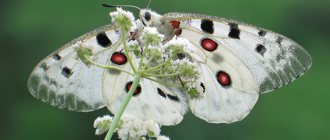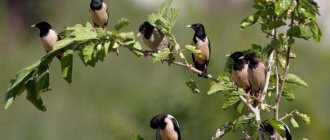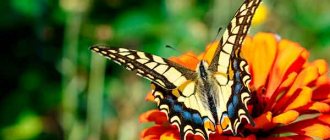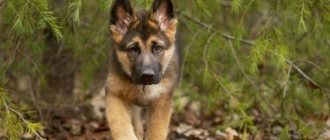On hot summer days, on forest edges, in gardens or along roads, you can see bright butterflies fluttering over flowers. The unusual velvety black color with red bands attracts attention. This is an admiral butterfly. The Latin name is no less interesting - Vanessaatlanta. The species designation "Atlanta" has ancient Greek roots. This was the name of the heroine of myths, who defeated all her rivals in the race. The admiral butterfly does not run, but flies perfectly. She is an active migrant, flying thousands of kilometers in search of comfortable habitats.
Description of the species
The admiral butterfly belongs to the nymphalidae family, genus Vanessa. The length of the insect's front wing reaches 30 mm, the wingspan is 50-65 mm. Vanessa atlanta diurnal butterfly with a wavy outer edge of the wings and a noticeable projection on the forewing. This structure is typical for the Vanessa genus. The upper edge of the wings is dark brown or brown. At the top of the forewing there is a noticeably elongated white spot, next to it there is a chain of light spots of various shapes and sizes.
The photo clearly shows the red band that diagonally crosses the middle of the front wing of the admiral butterfly. At the outer edge of the hind wings there is a stripe of similar color. There are 4-5 black dots located in a row on it. There is a blue elongated spot in the corner of the hind wing. The back of the wings is covered with a motley mosaic pattern of red, white, gray and brown stains. On the front wings, the main pattern is complemented by blue rings and stripes.
The body of the insect is brown or black, the chest is covered with long brown hairs. The head is inactive, with large compound eyes located on the sides. Admirals distinguish many colors: blue, green, yellow, but do not notice red. Small bristles grow around the organs of vision. Between them in the frontal part there are segmented antennae. For admirals they end in an extended mace. At the bottom of the head there is a mouthparts in the form of a proboscis. In a calm state, it curls up into a spiral. The butterfly uses its proboscis to suck nectar into its throat.
The thoracic region consists of three segments, each of which bears a pair of walking legs. The forelimbs of the nymphalid family are covered with dense bristles, which act as an organ of touch.
Interesting Facts
Admiral butterflies have been known to mankind for several hundred years. But many people are not even aware of the existence of several interesting facts related to these cute insects:
- In the second edition of the Great Soviet Encyclopedia, there was no article about butterflies of this species. The reason for this was Colonel General A.P. Pokrovsky, who ordered the publication to be removed, since it followed an article about the military rank of the same name. Pokrovsky considered that it was inappropriate to post such a serious publication and a note about butterflies next to each other.
- The very name of the butterfly, “Admiral,” actually has nothing to do with military rank. The insect received this name from the distorted English word “admirable,” which translates as “wonderful.”
- The Admiral butterfly travels a distance of 3000 km in about 35-40 days. In this case, the average flight speed of an insect can reach 15-16 km/h.
Lifestyle
A description of the admiral butterfly will be incomplete without talking about the features of its lifestyle. The insect is a heat-loving species and spends the winter only in the southern regions. During migration, moths rise to a considerable height, where they are picked up by the wind and carried in the desired direction. This saves the insects' energy. The summer begins in May-June and continues until the end of September. One, sometimes two generations are replaced per year. The second generation has darker wings.
The English name of the insect RedAdmiral (red admiral) accurately characterizes the unique coloring of the butterfly. The mobile species can be found in any unexpected places - on the river bank, in a city park, on a farm. Admirals are active on sunny days in clear weather. On rainy and windy days they hide in a shelter.
Information. Vanessaatlanta often rest on the trunks of oak or larch trees. Butterflies put their wings behind their backs and completely merge with the bark of trees. Their camouflage coloring hides them from predators.
Lepidoptera are insects with complete metamorphosis. They go through all stages of development: egg, larva (caterpillar), pupa, imago. How long does the admiral butterfly live? In favorable conditions, it is long-lived - the insect lives 9-10 months. For part of the allotted period, it remains in hibernation; it is the presence of diapause that explains its long existence. The fertilized female overwinters in order to immediately lay eggs the next year after waking up. In the North and Center of Europe, admirals do not stay during the cold period. They go on a seasonal migration south. It is less noticeable than in summer, when a large number of adults settle in gardens and parks rich in food.
Migrants that appear in the summer produce offspring on local plants. Young butterflies fly in July-August. They are not shy; if handled carefully, they can land on clothing or a hand. It is easy to distinguish between visiting and local admirals by the condition of their wings - travelers’ wings are tattered and faded. During the wintering period, moths look for a reliable shelter where they can hide not only from the cold, but also from enemies. Females hide under the bark of trees, fallen leaves, and hide in crevices. While sleeping, they run the risk of being eaten by birds or rodents.
General climate warming and mild winters have led to changes in the behavior of the admiral butterfly. Not all individuals go to wait out the cold season in hot Africa. Some remain in temperate latitudes. This decision is completely justified, because many insects die while covering distances of thousands of kilometers.
Nutritional Features
What does the admiral butterfly eat? Adults prefer to drink nectar from asteraceous plants:
- cornflower;
- thistle;
- ivy;
- blackberry;
- scabious;
- Asteraceae
At the end of summer, moths have the opportunity to expand their diet with overripe sweet fruits. They drink the juice of bursting peaches, plums, and pears.
Interesting fact. Admirals prefer rotten and fermented fruits.
Habitat of the admiral butterfly
The butterfly is a numerous species, the distribution of which covers the territories of extratropical Eurasia, the island zones of the Atlantic Ocean (Azores and Canary Islands), North Africa, North America, Haiti, and New Zealand.
In Asia Minor and the Middle East, the admiral butterfly is known. Whatever natural zone the insects are in, they head to the southern regions of their range to spend the winter. Being active migrants, they make gigantic flights. It’s hard to believe how fragile creatures get to Africa, where not even all birds can fly to winter. Of course, many travelers die along the way.
The strongest ones fly to the mainland to lay eggs and complete their life journey. The stronger offspring will go back next year. Some individuals do not fly away to their winter quarters; they seek shelter from the cold in crevices and under the bark of trees.
The spring sun awakens them, they leave their shelters to decorate the natural world coming to life after hibernation with their appearance. Where the admiral butterfly lives , the world is perceived as warm and colorful.
The active time of the warm season lasts from late May - early June until October in some regions. In Russia, the admiral butterfly is known in the forests of the Central part, in the Eastern Caucasus, the Urals, Karelia and other places. In mountainous areas, the bright admiral is observed at altitudes of up to 2500-2700 m above sea level.
The insect is often found on the edges, in open forest areas, in floodplain and mountain meadows, and in forest belts. A common sight is to see a butterfly on the side of the road, along the banks of rivers and lakes, in a forest clearing, among country gardens or in the garden.
In late summer they can be found on overripe fruits that have fallen from fruit trees or on trunks. Summer residents often observe butterflies on plums and pears. This is one of the many butterflies that can be seen last before the cold weather arrives. The light of the fire attracts her trusting appearance, the nectar of autumn flowers serves as nourishment on warm days.
Interestingly, the red-orange admirals that have overwintered in secluded places have a more saturated coloration compared to those that have not yet passed the seasonal test. In southern Europe, where winters are mild, warm sunny days can “deceive” sleeping beauties, who fly out to the delight of people.
The dynamic abundance of the species fluctuates quite significantly. The populations of the northern regions of the range are replenished after migrations from the south, the forest belts of Eurasia are partially renewed by such southern migrants.
Reproduction
Vanessaatlanta moths are characterized by courtship and mating games. During the breeding season, males exhibit territorial behavior. They occupy good areas where food plants grow and drive away competitors. Each has a territory of 10 by 20 m. Moths patrol their own area, flying around the perimeter. Admirals often circle over the hills to spot and intercept a passing female from afar. The male flies for a long time after his partner, seeking her favor. Mating takes place over several hours. During this period, insects do not respond to external factors and are in a vulnerable position.
Interesting fact. Territorial males, who aggressively drive rivals of their species and other butterflies out of their area, demonstrate peaceful behavior while feeding on flowers or fruits.
The fertilized female lays one egg at a time on the upper part of the leaves of the food plants:
- thistle (Carduus);
- stinging nettle (Urticadiolica);
- stinging nettle (Urticaurens);
- hops (Humuluslupulus).
Laying takes a long time. Periodically, the female breaks off and flies away to refresh herself with nectar from nearby flowers or tree sap. A situation often occurs when several admirals lay eggs on one nettle bush at once.
Development of offspring
Initially they are light green, but as the embryo develops they become darker in color. The eggs are small, 0.8 mm in size, and are difficult to notice with the naked eye. A week later the larva appears. What does an admiral butterfly caterpillar look like? When emerging from the egg, it is green in color and the body is covered with bristles. The head is large, black and shiny. The size of the larva is 1.8 mm. Caterpillars live separately, building peculiar houses from rolled leaves fastened with cobwebs. The shelter is left only for food. After molting, a new, larger house is built.
Information. A few curled nettle leaves are a clear sign of the presence of admiral larva.
As it grows, the color of the caterpillar changes. There are specimens of yellow-green, brown or black color. The body is completely covered with small white dots, branched spines and growths. There are light yellow stripes on the sides. The admiral butterfly caterpillar goes through 5 instars. This takes about 1 month. The first four instars take 3-4 days, the fifth is the longest. An adult caterpillar grows up to 35 mm. There are seven longitudinal rows of sharp spines on her body. The last larval stage takes 10 days.
At the end of development the larva stops feeding. She gnaws the base of the leaf so that the house hangs on the veins of the petiole. Inside such a structure, the caterpillar pupates upside down. The length of the pupa is 22-23 mm, the color is gray or brown with silver inclusions. The duration of the phase depends on the temperature. At +30°C, the adult appears in 6-7 days; if the indicator drops to +11-18°C, the time increases to 18-45 days. A young butterfly emerges from the pupa. Her wings are small and take time to spread.
Features of life
Admiral butterflies are constantly on the move. On warm sunny days they are found in gardens, parks and near ponds. It is difficult to see an adult individual - the camouflage works so well. Insects are not afraid of people - a butterfly easily lands on the palm or shoulder of a person. Look closely at the individual. Moths arriving from other places have less rich colors and wings that are faded. The locals, on the contrary, have bright colors, the picture is always the same.
Predators are dangerous to insects at every stage of development. The following enemies of admirals in nature are known:
- the bats;
- birds;
- spiders;
- ants;
- wasps;
- frogs;
- lizards.
Not all predators are at risk of associating with this species. Birds are frightened by the bright colors of butterflies and the spines of hairy caterpillars. Only cuckoos eat larvae without fear.
What does the admiral butterfly eat? Caterpillars prefer nettles and thistles, and moths feed on the nectar of cornflowers and flowering hops. Colorful insects choose red clover, alfalfa and aster. Fermented fruits are a favorite dish for those with a sweet tooth. Admirals love overripe fruits and enjoy the nectar of cracked peaches and plums.
Keeping at home
Fauna lovers keep various insects as pets, including butterflies. It is better to take Lepidoptera when they are caterpillars. The insect is placed in an aquarium or plastic container filled with food plants. The top of the container is covered with a mesh to provide air access. Food is replaced every day. The leaves are periodically sprinkled with water. During the pupation period, the humidity in the container should be 80-09%.
For young adults, it is necessary to provide a place for spreading their wings. A vertical branch will do. How long does the admiral butterfly live at home? Don't expect the insect to stay in your home for a long time. The life of a moth is short; even in safe conditions it will live no more than 3-4 weeks. The pet will need a certain temperature and humidity, as well as food.
The diet of domestic butterflies includes a solution of honey and fruit juice. Preparing the syrup is quite simple - dilute a teaspoon of honey in 6 portions of water. You can offer the insect juicy cut fruits (banana, plum, peach). It is enough for the butterfly to touch the honey solution with its paw to identify it as food.
It is interesting to watch a butterfly having lunch. She sits on the edge of the saucer and dips her long proboscis into the sweet liquid. After 5-15 minutes the food ends. It is enough to feed the moth once a day.
Story
A rich palette of colors and intricate patterns on the wings distinguish butterflies from other insects. It is no wonder that these sublime creatures are given the names of heroes of ancient myths. The admiral butterfly is named after Vanessa Atalanta (from the Latin: vanessa atalanta). Carl Linnaeus chose for the new species the name of the daughter of the hero Scheneus, who dreamed of a son. In Ancient Greece, it was believed that an upset father got rid of Vanessa by throwing her off a mountain. A beautiful girl spent her life in the forest. See what types of butterflies exist.
There are two known versions of the origin of the name Admiral. According to the first, the name comes from a Turkish word that translates as “lord of the seas.” Although the butterfly prefers to live in meadows, it easily goes on long journeys and flies across bodies of water.
The second version is marine - the insect was so called because of its color. Red stripes on a dark background are reminiscent of admiral's ribbons - the kind that fleet commanders had.
In crossword puzzles there is a question about the naval butterfly. If you see him, try using the word “admiral.”
Related species
The burdock butterfly is called the pink admiral and thistle. Her Latin name is Vanessacardui. Insects belong to the same genus (Vanessa) and family (Nymphalidae). The wing size is 47-65 mm, the color is light red with a pinkish tint. On a bright background there is a pattern of black and white spots and bands. The butterfly is known for its long-distance flights. This species winters in North Africa, and with the onset of warm weather migrates to Europe and Asia. Some individuals were found in Iceland. Thistles have been spotted in the Kamchatka nature reserve.
Guests from the south breed in summer in temperate latitudes. They lay one egg on food plants: coltsfoot, nettle, yarrow, thistle. In the fall, adults return to Africa.
Natural enemies
The parasites of the admiral's caterpillars are the tachine flies Sturmia bella, Compsilura cocinnata, Voria ruralis, the ichneumonid fly Ctenichneumon castigator and Diadegma majale, and the braconid Cotesia vanessae. The pupae are parasitized by the pteromalid Pteromalus briani.
Among the predators, the admiral is attacked by large dragonflies, for example, the Emperor's Watcher. Song grasshoppers and insectivorous birds feed on caterpillars.
Photo credit: Andrew C, CC BY 2.0
Insect protection
The reduction in the number of Vanessaatlanta required the adoption of protective measures. In 1997, the insect was included in the Red Book of Russia. Several favorable years allowed the number of nymphalids to replenish. Security measures were maintained only in the Smolensk region. Negative factors affecting insects are deforestation, plowing of meadows, and treatment of gardens with chemicals. At the moment, admiral moths are not in danger of extinction. The colonies are actively replenished by insects migrating from the south. The admiral butterfly is considered one of the most beautiful species in Europe.
Benefits and harms
There is practically no harm from the admiral butterfly from an economic point of view. Adults are even useful because they participate in plant pollination. But caterpillars can actually eat leaves significantly, especially in hop plantings.
Photo: astroforum.tomsk.ru
Robin (50 photos): description of the bird, where it lives and what it eats
Blueberry (lat. Polyommatus icarus)
A small, cute butterfly with an unusual color of wings. Moreover, only males are painted azure, while females have brown wings.
Blueberry Icarus is distributed unusually widely: throughout extratropical Eurasia.
blue butterfly
The eyes painted on the back of the wings are small. Therefore, they will not be able to scare a predator. But bluebirds use their eyes to disorient the birds. Some pigeons have their heads “painted” at the bottom of their wings. When a bird pecks a butterfly on this head, only a piece of its wing remains, and the butterfly manages to escape.
Blueberry Icarus
Bluebirds have one interesting feature. The young caterpillars that hatch from the egg first feed on the leaves. They secrete a secretion with a special smell, thus “disguising” themselves as ant larvae. They take them to the anthill and feed them along with their own offspring. Moreover, the caterpillars not only rob the larvae, but also eat them. However, the ants have found a way to resist these insidious predators. The smell of their larvae is constantly changing, and only those caterpillars survive that best managed to adapt to the standard. This does not allow the bluebirds to increase their numbers too much and bring the anthill to death.
Yellowtail (Euproctis similis)
Small butterfly. The forewings are 16–19 mm, white, monochromatic, or with a small grayish spot at the rear corner. The body of the butterfly is covered with thick white hairs, yellow in the lower part of the abdomen, the wings are also white, on which two black dots clearly stand out. The end of the abdomen is covered with orange-yellow hairs, more abundant in females, which is why it got its name. These hairs are separated and used by them to camouflage the eggs they lay.
The yellowtail lives mainly in park areas, deciduous forests and orchards.
Adult years occur in the second half of June and July.
Yellowtail (yellowtail), caterpillar
The caterpillars are black, with two longitudinal red lines on the back, and covered with long grayish hairs. It feeds on the buds and leaves of apple, pear, bird cherry, rose hip, as well as willow, birch, poplar, aspen, oak, and hornbeam.
Classification
Admiral is the type species of the genus Vanessa. It is divided into two geographically isolated subspecies. Data on intraspecific taxonomy are provided by Field and Markku Savela on the website. (checked 10/06/2019).
Below is information about the admiral varieties.
Vanessa atalanta atalanta (Linnaeus, 1758)
Found in Eurasia and North Africa. The Eurasian subspecies has a narrower white band at the top of the forewings and smaller black spots on the orange band on the hindwings.
Vanessa atalanta rubria (Fruhstorfer, 1909)
Lives in North America. This subspecies shows slight variations in color throughout the year. Butterflies of the summer generation are somewhat darker and larger than spring individuals, and the stripe on the forewing is narrower and more reddish in color.
Photo credit: Emmanuel Boutet, CC BY-SA 3.0
A unique Mexican nature reserve: a place where butterflies rain
Not far from Mexico City there is a unique unique city: millions of migrating moths, among which Admirals have been spotted, annually travel to protected forests and literally litter local trees. As part of their “pilgrimage” from North America, they travel more than 4,000 km , which is a unique phenomenon in the world of butterflies.
As a result, millions (perhaps even billions) of migrating moths gather together: they instantly fill the horizon, their wings making a sound similar to the sound of rain. The insects then gather in a relatively small forest area and cover the trees in such numbers that they bend under the unexpected weight.
But with the arrival of the first days of spring, the butterflies leave their habitat and travel to eastern Canada, where they live for the next 8 months.











